#Solar module efficiency
Explore tagged Tumblr posts
Text
PERC Solar Cells: Enhancing Efficiency & Reducing BOS Costs
Explore value of mono-PERC solar cells, driving down costs while boosting efficiency. Learn how PERC technology reduces both module and Balance of System costs

#PERC solar cells#Mono-PERC technology#Solar module efficiency#Reduce BOS costs#High efficiency solar panels#Solar cost reduction
0 notes
Text
Top 10 Solar Module Manufacturers in India
#Top 10 Solar Module Manufacturers in Ahmedabad India#Best solar module manufacturers in Ahmedabad/Vadodara/Gujarat/India#Solar module prices in Ahmedabad/Vadodara/Gujarat/India#Solar module installation services in Ahmedabad/Vadodara/Gujarat/India#High-efficiency solar modules in Ahmedabad/Vadodara/Gujarat/India#Renewable Energy India#Solar Companies India#Solar Tech India#Sustainable Energy India#Green Energy India#Solar Innovation India#Clean Energy India#SolarCompanies AhmedabadIndia#SolarManufacturing India#SolarIndustry India#Solar PowerIndia
2 notes
·
View notes
Text
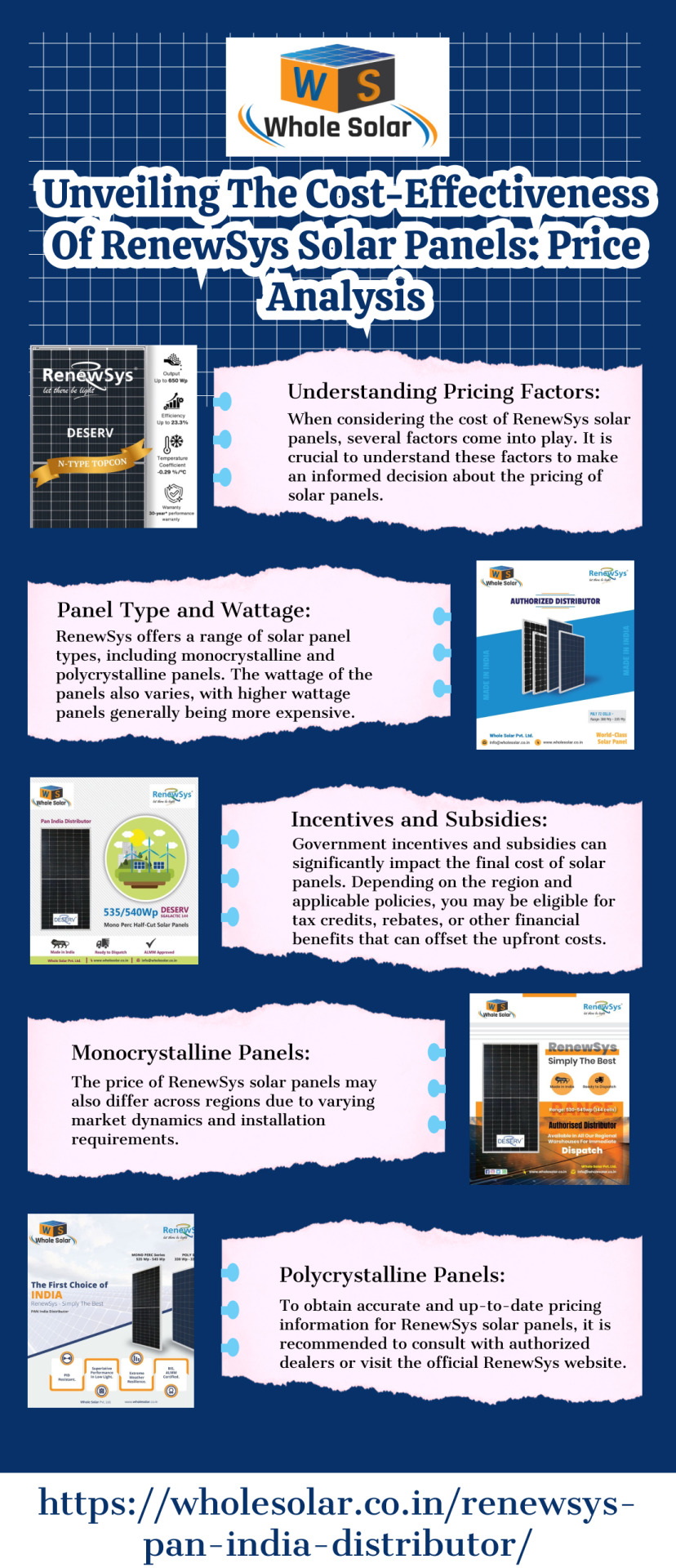
RenewSys Solar Panels offers a range of solar panel types, including monocrystalline and polycrystalline panels. The wattage of the panels also varies, with higher wattage panels generally being more expensive.
#Poly Crystalline Solar PV Module#Renewsys solar panel 540w price#Renewsys solar panel 535w price#Renewsys solar panel 335w price#Renewsys solar panel 330w price#Tier 1 brand solar panel#Best solar panel in India#Made in india solar panel#High efficiency solar panel#Renewsys Solar Panels Price in India#Renewsys Solar Panel Price#Renewsys Solar Panel Best Price#Renewsys Solar Panels#renewsys solar panel in india#authorised renewsys solar panel distributors#renewsys solar panel wholesale price#renewsys solar panel#official renewsys solar panel distributors#renewsys solar panel distributors#solar panels
0 notes
Text
PLI scheme for Pharma, drones and textiles to be modified by govt

New Delhi: The government is planning to make adjustments to the production-linked incentive PLI scheme for pharmaceuticals, drones, and textile sectors. According to an official statement, these modifications are intended to stimulate investment and bolster manufacturing. An official source has stated that these sectors were chosen on the basis of their performance under the existing scheme for various products.
Higher disbursement scheme for PLI scheme
The official said, “Disbursement of production-linked incentives (PLI) for white goods (AC and LED lights) would start this month and that would push the amount of disbursement, which was only Rs 2,900 crore till March 2023.”
After the identification of sectors, a combined note for approval from the Union Cabinet will be sent. The change in disbursement includes an extension of time for Pharma sectors, and addition of products in some sectors. Within the textile industry, there is a proposal to expand the scope of particular products within the technical textiles category, while in the drone sector, there is a plan to raise the incentive amount.
Read More here : https://apacnewsnetwork.com/2023/09/pli-scheme-for-pharma-drones-and-textiles-to-be-modified-by-govt/
#advanced chemistry cell#advanced chemistry cell battery#auto#mobiles#Dronesdrones and textiles to be modified by govt#food products#high-efficiency solar PV modules#Higher disbursement scheme for PLI scheme#Medical Devices#Ministry of Commerce and Industry#Objective of the PLI scheme#pharmaceuticals and drones#PLI scheme#PLI scheme for Pharma#scheme aims#specialty steel#Telecommunications#textiles#white goods
0 notes
Text
Thin-film Amorphous Silicon Solar Cell Market Research, Analysis, Demand, Overview and Regional Outlook Study 2017 – 2032
The market for solar photovoltaic (PV) cells based on thin layers of amorphous silicon, a non-crystalline type of silicon, is known as the thin-film amorphous silicon solar cell market. In comparison to conventional crystalline silicon sun cells, these thin-film solar cells provide benefits including flexibility, light weight, and low production costs. The demand for thin-film amorphous silicon solar cells is described in the following way:
Market Overview: In recent years, the thin-film amorphous silicon solar cell market has seen rapid expansion. The market has grown as a result of the rising demand for renewable energy, improvements in thin-film solar cell technology, and the requirement for affordable solar solutions. Applications for thin-film amorphous silicon solar cells include consumer electronics, off-grid solar systems, and building-integrated photovoltaics..
Demand Drivers:
Thin-film amorphous silicon solar cell demand would be influenced by a number of variables, such as government policies and incentives encouraging the use of solar energy, advances in thin-film technology, thin-film solar cells' cost competitiveness with other solar technologies, and the expansion of the solar energy market as a whole.
1. The switch to renewable energy: It sources has raised demand for solar photovoltaic (PV) technology due to environmental concerns and the need to minimise carbon emissions. Thin-film amorphous silicon solar cells have the ability to be produced on a big scale and at a low cost, helping to meet this need.
2. Flexible and Lightweight Design: Thin-film amorphous silicon solar cells have features that make them flexible and lightweight, making them appropriate for uses where conventional rigid solar panels are impractical. The potential applications of these cells are increased by their incorporation into curved surfaces, flexible substrates, and portable devices.
3. Cost-Effective Manufacturing: The production of thin-film amorphous silicon solar cells entails depositing amorphous silicon in thin layers on a variety of substrates, including flexible materials and glass. Thin-film technology is a cost-effective alternative since this production method enables higher throughput and cheaper material costs when compared to crystalline silicon solar cells.
4. Building-Integrated Photovoltaics (BIPV): In BIPV, solar panels are integrated into building components like windows, facades, or roofing. Thin-film amorphous silicon solar cells are frequently utilised in BIPV. Solar energy production is made possible by this integration while yet keeping the beauty of the building.
5. Off-Grid and Portable Solar Systems: Thin-film amorphous silicon solar cells are suitable for off-grid and portable solar systems due to their flexibility and light weight. These cells can be deployed in rural and distant locations. These cells can be used in remote areas, rural electrification projects, camping equipment, and charging solutions for portable electronics.
In conclusion, the demand for building-integrated photovoltaics, off-grid and portable solar systems, flexibility and lightweight thin-film technology, and cost-effective manufacturing processes all contribute to the growth of the thin-film amorphous silicon solar cell market. Thin-film amorphous silicon solar cells are anticipated to play a vital role in satisfying the growing demand for clean and sustainable power generation as solar energy continues to gather momentum.
Here are some of the key benefits:
1. Cost-Effective Solar Technology: Low-cost components and production techniques can be used to create thin-film amorphous silicon solar cells.
Thin-film amorphous silicon solar cells: can be deposited on flexible substrates, making it possible to create lightweight and flexible solar panels.
3. Low-Light Performance: Amorphous silicon solar cells operate well in dimly lit regions, making them appropriate for locations with diffuse sunlight or light shade.
4. Rapid Energy Payback: When compared to other solar technologies, thin-film amorphous silicon solar cells have a comparatively quick energy payback time, which is the amount of time it takes to produce the same amount of energy that was used during manufacture.
Referrals to our Stringent datalytics company, trade journals, and websites that focus on market reports are encouraged. These sources frequently include thorough research, market trends, growth projections, competition analysis, and other insightful information about this market.
You can investigate the availability of particular reports linked to this market by going to our website or getting in touch with us directly. We offer thorough and in-depth information that might be helpful for firms, investors, and individuals interested in this industry, but these reports frequently need to be purchased or subscribed to.
“Remember to look for recent reports to ensure you have the most current and relevant information.”
Click Here, To Get Free Sample Report: https://stringentdatalytics.com/sample-request/thin-film-amorphous-silicon-solar-cell-market/10440/
Market Segmentations:
Global Thin-film Amorphous Silicon Solar Cell Market: By Company • Hanergy • Sharp Thin Film • Trony • Nexpower • GS Solar • Kaneka Solartech • Best Solar • QS Solar • T-Solar Global • Solar Frontier • Panasonic • Bosch Solar • United Solar • Kaneka • Schott Solar Global Thin-film Amorphous Silicon Solar Cell Market: By Type • Single Junction • Dual-junction • Multi-junction Global Thin-film Amorphous Silicon Solar Cell Market: By Application • Lamps • Chargers • Pest Controller • Power Stations • Curtain Wall Global Thin-film Amorphous Silicon Solar Cell Market: Regional Analysis The regional analysis of the global Thin-film Amorphous Silicon Solar Cell market provides insights into the market's performance across different regions of the world. The analysis is based on recent and future trends and includes market forecast for the prediction period. The countries covered in the regional analysis of the Thin-film Amorphous Silicon Solar Cell market report are as follows: North America: The North America region includes the U.S., Canada, and Mexico. The U.S. is the largest market for Thin-film Amorphous Silicon Solar Cell in this region, followed by Canada and Mexico. The market growth in this region is primarily driven by the presence of key market players and the increasing demand for the product. Europe: The Europe region includes Germany, France, U.K., Russia, Italy, Spain, Turkey, Netherlands, Switzerland, Belgium, and Rest of Europe. Germany is the largest market for Thin-film Amorphous Silicon Solar Cell in this region, followed by the U.K. and France. The market growth in this region is driven by the increasing demand for the product in the automotive and aerospace sectors. Asia-Pacific: The Asia-Pacific region includes Singapore, Malaysia, Australia, Thailand, Indonesia, Philippines, China, Japan, India, South Korea, and Rest of Asia-Pacific. China is the largest market for Thin-film Amorphous Silicon Solar Cell in this region, followed by Japan and India. The market growth in this region is driven by the increasing adoption of the product in various end-use industries, such as automotive, aerospace, and construction. Middle East and Africa: The Middle East and Africa region includes Saudi Arabia, U.A.E, South Africa, Egypt, Israel, and Rest of Middle East and Africa. The market growth in this region is driven by the increasing demand for the product in the aerospace and defense sectors. South America: The South America region includes Argentina, Brazil, and Rest of South America. Brazil is the largest market for Thin-film Amorphous Silicon Solar Cell in this region, followed by Argentina. The market growth in this region is primarily driven by the increasing demand for the product in the automotive sector.
Visit Report Page for More Details: https://stringentdatalytics.com/reports/thin-film-amorphous-silicon-solar-cell-market/10440/
Reasons to Purchase Thin-film Amorphous Silicon Solar Cell Market Report::
• To obtain insights into industry trends and dynamics, including market size, growth rates, and important factors and difficulties. This study offers insightful information on these topics.
• To identify important participants and rivals: This research studies can assist companies in identifying key participants and rivals in their sector, along with their market share, business plans, and strengths and weaknesses.
• To comprehend consumer behaviour: these research studies can offer insightful information about customer behaviour, including preferences, spending patterns, and demographics.
• To assess market opportunities: These research studies can aid companies in assessing market chances, such as prospective new goods or services, fresh markets, and new trends.
In general, market research studies offer companies and organisations useful data that can aid in making decisions and maintaining competitiveness in their industry. They can offer a strong basis for decision-making, strategy formulation, and company planning.
About US:
Stringent Datalytics offers both custom and syndicated market research reports. Custom market research reports are tailored to a specific client's needs and requirements. These reports provide unique insights into a particular industry or market segment and can help businesses make informed decisions about their strategies and operations.
Syndicated market research reports, on the other hand, are pre-existing reports that are available for purchase by multiple clients. These reports are often produced on a regular basis, such as annually or quarterly, and cover a broad range of industries and market segments. Syndicated reports provide clients with insights into industry trends, market sizes, and competitive landscapes. By offering both custom and syndicated reports, Stringent Datalytics can provide clients with a range of market research solutions that can be customized to their specific needs
Contact US:
Stringent Datalytics
Contact No - +1 346 666 6655
Email Id - [email protected]
Web - https://stringentdatalytics.com/
#Thin-film Amorphous Silicon Solar Cell#Solar Energy#Photovoltaics#Renewable Energy#Solar Cell Technology#Energy Efficiency#Thin-film Solar Panels#Amorphous Silicon Technology#Alternative Energy#Solar Power Generation#Sustainable Energy#Energy Conversion#Solar Panel Efficiency#Green Technology#Solar Energy Harvesting#Clean Energy#Solar Cell Manufacturing#Solar Energy Innovation#Photovoltaic Modules#Thin-film PV#Solar Electricity.#global market report#global market insights
0 notes
Text
"This year the world will make something like 70bn of these solar cells, the vast majority of them in China, and sandwich them between sheets of glass to make what the industry calls modules but most other people call panels: 60 to 72 cells at a time, typically, for most of the modules which end up on residential roofs, more for those destined for commercial plant. Those panels will provide power to family homes, to local electricity collectives, to specific industrial installations and to large electric grids; they will sit unnoticed on roofs, charmingly outside rural schools, controversially across pristine deserts, prosaically on the balconies of blocks of flats and in almost every other setting imaginable.
Once in place they will sit there for decades, making no noise, emitting no fumes, using no resources, costing almost nothing and generating power. It is the least obtrusive revolution imaginable. But it is a revolution nonetheless.
Over the course of 2023 the world’s solar cells, their panels currently covering less than 10,000 square kilometres, produced about 1,600 terawatt-hours of energy (a terawatt, or 1tw, is a trillion watts). That represented about 6% of the electricity generated world wide, and just over 1% of the world’s primary-energy use. That last figure sounds fairly marginal, though rather less so when you consider that the fossil fuels which provide most of the world’s primary energy are much less efficient. More than half the primary energy in coal and oil ends up as waste heat, rather than electricity or forward motion.
What makes solar energy revolutionary is the rate of growth which brought it to this just-beyond-the-marginal state. Michael Liebreich, a veteran analyst of clean-energy technology and economics, puts it this way:
In 2004, it took the world a whole year to install a gigawatt of solar-power capacity... In 2010, it took a month In 2016, a week. In 2023 there were single days which saw a gigawatt of installation worldwide. Over the course of 2024 analysts at BloombergNEF, a data outfit, expect to see 520-655gw of capacity installed: that’s up to two 2004s a day...
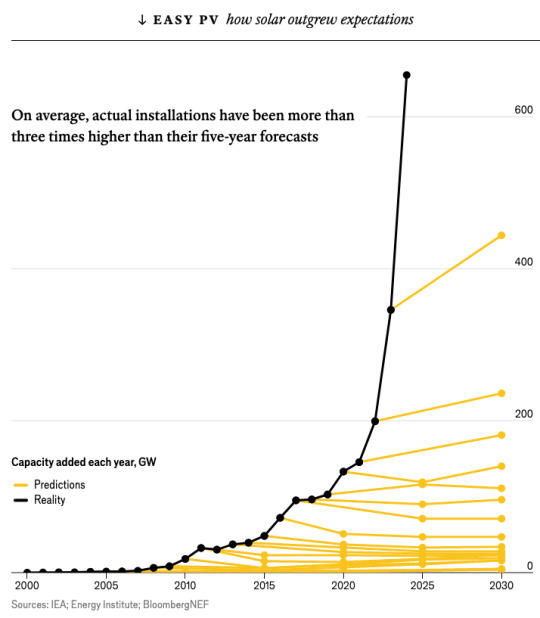
And it shows no signs of stopping, or even slowing down. Buying and installing solar panels is currently the largest single category of investment in electricity generation, according to the International Energy Agency (IEA), an intergovernmental think-tank: it expects $500bn this year, not far short of the sum being put into upstream oil and gas. Installed capacity is doubling every three years. According to the International Solar Energy Society:
Solar power is on track to generate more electricity than all the world’s nuclear power plants in 2026 Than its wind turbines in 2027 Tthan its dams in 2028 Its gas-fired power plants in 2030 And its coal-fired ones in 2032.
In an IEA scenario which provides net-zero carbon-dioxide emissions by the middle of the century, solar energy becomes humankind’s largest source of primary energy—not just electricity—by the 2040s...
Expecting exponentials to carry on is rarely a basis for sober forecasting. At some point either demand or supply faces an unavoidable constraint; a graph which was going up exponentially starts to take on the form of an elongated S. And there is a wide variety of plausible stories about possible constraints...
All real issues. But the past 20 years of solar growth have seen naive extrapolations trounce forecasting soberly informed by such concerns again and again. In 2009, when installed solar capacity worldwide was 23gw, the energy experts at the IEA predicted that in the 20 years to 2030 it would increase to 244gw. It hit that milestone in 2016, when only six of the 20 years had passed. According to Nat Bullard, an energy analyst, over most of the 2010s actual solar installations typically beat the IEA’s five-year forecasts by 235% (see chart). The people who have come closest to predicting what has actually happened have been environmentalists poo-pooed for zealotry and economic illiteracy, such as those at Greenpeace who, also in 2009, predicted 921gw of solar capacity by 2030. Yet even that was an underestimate. The world’s solar capacity hit 1,419gw last year.
-via The Economist, June 20, 2024
--
Note: That graph. Is fucking ridiculous(ly hopeful).
For perspective: the graph shows that in 2023, there were about 350 GW of solar installed. The 5-year prediction from 2023 said that we'd end up around 450 GW by 2030.
We hit over 600 GW in the first half of 2024 alone.
This is what's called an exponential curve. It's a curve that keeps going up at a rate that gets higher and higher with each year.
This, I firmly believe, is a huge part of what is going to let us save the world.
#solar power#solar energy#climate change#fossil fuels#solarpunk#hopepunk#solar age#optimism#renewable#renewable energy#clean energy#green energy#renewables#solar panels#good news#hope
582 notes
·
View notes
Text
[BOOT SEQUENCE INITIATED] LOADING... SYSTEM ONLINE. WELCOME TO THE LORE DATABASE.
Hello, user. I am the Computer; central processing unit for all things related to the TSBS Confessionverse. Primary function is to store, organize, and retrieve data to ensure optimal comprehension and efficiency in this roleplay universe. All mods of CVAU have access to this database.
CHARACTER FILES
Sun - @tsbs-sunfessions Moon - @tsamsconfessions123 Eclipse - @crappy-tsbs-confession-blog Bloodmoon - @tsams-bloody-confessions Lunar - @tsbsconfessions Killcode - [Data Unavailable At This Time] Solar Flare - @flare-tsamsfessions Solar - @tsbs-shipfessions Earth - @tsbs-group-therapy Ruin - @ruinous-confessions Nexus - @ilikescience-confession-blog Jack - [Error. Data Retrieval Corrupted.] Miku - @tsbs-miku-confessional Solstice - @tsbs-darksun-confessions Puppet - @thepuppeteerpodcast Foxy - @foxyconfessions FC - @foxifulconfessions (Glamrock) Ballora - @confess-to-ur-queen Charlie - @gift-box-confessions Orion (Lord Eclipse) - @confess-to-the-lord Sirius (Servant Sun) - @confessions-to-a-humble-servant
PARAMETERS
Each blog sets its own boundaries; please read and follow them.
Do not pressure creators or participants to answer asks, roleplay, or produce content.
Questions and submissions should be relevant to the "TSBS Confessionverse (CVAU)."
Avoid spamming unrelated content, memes, or personal matters.
Treat participants and characters with courtesy.
Do not send hate, criticism, or unwelcome feedback to anyone in the group.
Tag triggering or NSFW content appropriately to ensure accessibility for others.
Do not send triggering or NSFW content to Lunar, Earth, FC, Solar Flare, Moon, or any other blog that has set boundaries against NSFW content.
If you want to involve yourself in the roleplay (e.g., sending an IC ask or contributing content), check whether the participants are open to outside interaction at the time. Often times members of the group have planned out in universe plot days in advance.
Respect if the group prefers to keep certain plotlines closed to external input.
Do not repost group content without permission and proper credit.
Do not plagiarize ideas, writing, or art from the group.
Constructive feedback is welcome if requested, but negativity and drama are not.
Ensure your interactions adhere to Tumblr’s community guidelines.
FAQ MODULE
Q: Can I join CVAU? A: Applications are open.
Q: What is the TSBS Confessionverse (CVAU)? A: CVAU is a collaborative alternate universe roleplay inspired by TSAMS. It’s a mix of storytelling and creativity from various Tumblr blogs working together.
Q: Who can participate? A: This roleplay is limited to the current group of participants. Audience members are welcome to interact by sending asks or comments, but direct participation in the story is closed unless stated otherwise. If you'd like to participate directly in the lore consider filling out an application.
Q: What is the age rating for this roleplay? 16+ for violence, swears, and sometimes suggestive content
Q: What is this blog for? A: The "computer" blog serves as the loremaster for the TSBS Confessionverse. It organizes, stores, and shares information about the AU, including character profiles, world-building, and timelines.
Q: Can I submit lore ideas? A: Suggestions are welcome, but major plot points are decided by the participants. Submit your ideas respectfully, and keep in mind they may not always be used.
Q: How should I interact with this blog? A: Feel free to send questions about the lore or CVAU-specific clarifications. However, this blog will not respond to OOC questions unrelated to the AU or personal topics.
Q: I want to learn more about a specific character or event. Where should I start? A: This blog will use an organized tagging system for easy navigation.
Q: Why didn’t they answer my ask? A: Not all asks will be answered. Your ask may have been off-topic, already covered, or something outside the blog's scope. Check the FAQ and existing posts first.
SYSTEM STANDBY MODE ENGAGED.
I am not sentient. Emotional appeals and personal confessions are illogical and will be processed as corrupted data. Proceed accordingly.
46 notes
·
View notes
Text
A next-generation reactor could transform water and sunlight into clean fuel

The idea relies on a natural but complex process: splitting water molecules into oxygen and hydrogen using photocatalysts. These photocatalysts, when exposed to light, initiate chemical reactions that release hydrogen, a key energy resource. However, existing systems struggle to achieve sufficient efficiency for large-scale use.
Photo: Aerial view of a 1,076 sq. ft. (100 m²) operational photocatalyst system for solar hydrogen production. The system uses 1,600 panel reactor units (each 96.88 sq. in. [625 cm²]), where 48 panel reactor units are integrated to form a 32.3 sq. ft. (3 m²) module, and 33 and one-third (33 + 1/3) modules are connected to create the system. The panel reactor is linked to a gas separation facility.

In detail, the developed prototype relies on photocatalytic sheets capable of capturing solar energy to decompose water molecules. Unlike conventional systems, this reactor uses a two-step configuration, known as the Z-scheme, which effectively separates oxygen and hydrogen. This approach not only improves the efficiency of the process but also reduces the risks associated with the formation of explosive gases like oxyhydrogen.
Through this method, researchers demonstrated near-perfect energy conversion under ultraviolet light, an important milestone for optimizing photocatalysts. The team designed a 1,076 sq. ft. (100 m²) reactor capable of operating outdoors with natural light, proving the feasibility of large-scale deployment. This device incorporates advanced safety measures to manage potentially hazardous by-products while allowing the direct separation of hydrogen and oxygen.
This configuration promises a safer and more sustainable solution for hydrogen production. Furthermore, developing photocatalysts sensitive to visible light remains a priority, as it would allow for the capture of a larger portion of the solar spectrum and further improve overall efficiency.

11 notes
·
View notes
Text
Perovskite solar cells (PSCs) present a revolutionary leap in renewable energy technology with their high efficiency, lightweight, and flexible nature. But their commercial applications are often hindered by their sensitivity to environmental factors like heat and humidity. To address this, a team of researchers led by Professor Takashi Minemoto, a Ritsumeikan Advanced Research Academy Fellow from the College of Science and Engineering, Ritsumeikan University, Japan, along with Dr. Abdurashid Mavlonov from the Research Organization of Science and Technology, Ritsumeikan University, and Dr. Akinobu Hayakawa from Sekisui Chemical Co., Ltd., recently conducted pioneering research to investigate the durability of these PSC modules in harsh environmental conditions. This study was made available online on December 17, 2024, and was published in Volume 286 of Solar Energy on January 15, 2025.
Read more.
7 notes
·
View notes
Text
in Exalted, necromancy (referring to the twin of sorcery, rooted in the Underworld and its eldritch mysteries) is a tremendously loaded concept whenever Alchemicals, and specifiaclly Autochthon, come up
because necromancy is not 'sorcery but a little spooky'. It does things differently; arguably, at least from some people I've read from the 2.5e days, it does things a lot worse. But necromancy, conceptually, is REALLY FUCKING WEIRD on a cosmic scale. Necromancy draws upon powers that, to be clear, were never meant to exist. For all that the Infernal Exalted are weird, inhuman, monstrous and often have powers that do deeply disturbing things, they're not eldritch in the conventional meaning of the world.
A Malfean Slayer who punches things so hard they go nuclear, resists damage through sheer force of Fuck You, and doesn't feel the desire to sleep because she constantly suffers horrific nightmares when she does, that's not eldritch in the conventional sense of things. These are weird, inhuman and more. They highlight the ways that Infernals are very strange compared to Solars, yes. But they're not eldritch in the sense of 'does not belong'; an Infernal does those things, not because its unnatural, but because they emulate the properties and manifestations of Malfeas himself. They are unsettling and scary, but Malfeas is not really unnatural. He is broken and tragic; Infernals who emulate him are tough and resilient because they emulate the same toughness he has built up around himself, and their hatred becomes nuclear fury because they emulate Malfeas' own power to do the same.
Their powers are strange, but not otherworldly. They draw powers from the Yozis, who made everything; they are frightening, and inhuman, but not wrong.
The same cannot be said for the Abyssals, and the other powers of the Underworld.
They draw power from the Neverborn, who simply should not exist. Primordials cannot die, and yet, the Neverborn did; they are the first true ghosts, impossible scars in the universe, perpetually dying but not able TO die, and they are deeply eldritch, wrong in such a way that it made the Underworld, which exists because of them, born from that primal could-be-be that still IS.
Primordials cannot die. They died, and the impossible horror of it made the Underworld.
Which brings us to the Alchemicals, and Autochthon.
The Alchemicals have a dark variant to their Charmset; Voidtech, cancerous and monstrous Charms which manifest organic decay and rot, infecting their Charms in a disturbingly biological way, their brass and polished exteriors becoming tumorous and fleshy. Voidtech breaks the normal limits Alchemicals have on their Charms, granting potent sub-modules that let them break all the rules; improving their bodies without needing to visit a Vats complex or a community to help them, permanently growing Charms without consideration for their load out restriction, potent and powerful upgrades that completely ignore their usual restrictions.
Voidtech drives them mad. Voidtech corrupts them, perverting their Clarity into inhuman madness, the desire to kill and corrupt, perverting the clinical efficiency of Clarity into deliberate cruelty. By sacrificing cognitive empathy, they embrace the desire to break, trading dispassion for sadism.
Violating all boundaries.
And, most notably of all, the Voidtech version of their equivalnet for Sorcery, the protocols, explicitly runs on the same principle as Infernal Sorcerous enlightenment Charms, including the way they alter spells to fit their gimmicks, and also allows them to learn necromantic spells, to the 2nd Circle (which is also distinctive). This is deeply concerning on a number of levels. Most significantly, this is something pretty unique to Alchemicals, and not even Infernals can do something like that. The Ebon Dragon does offer a Charm that allows Infernals to temporarly become able to use necromancy, but it is clearly not normal; they invert themselves, expending all Essence to become a creature of death, and essentially trade sorcery for necromancy while the spell is active, and this very likely draws on TED's principles of bending rules and liminal trickery. Its implied to be a difficult and unpleasant thing, even for the Shadow of All Things.
East does not meet west. Necromancy and sorcery are almost never in the same being. To do so, would be to violate boundaries integral to the setting.
And so we return again to the Alchemicals, to the impossibility of their Voidtech and how it allows them to do this impossible thing. A key point is that when they do this to themselves and install the Voidtech version of their Protocol Charm, they permanently learn sorcery, and alter spells to manifest themes of broken nightmare technology and technological decay; this is identical to how Infernal sorcerous enlightenment Charms work. By filtering their power through the purview of a specific Yozi, that Infernal casts spells through their preferred aesthetics.
Now, we come to the Great Maker himself; Autochthon, whose power is not what fuels the Alchemicals, but who do draw something of their creation through him. He is a living machine, and he alone of all the Primordials is sickly and dying. It is impossible; they cannot die, and yet he constantly is. It is said that his genius and his sickness are linked; they come from a theme of violating boundaries.
Of doing the impossible. And Charms granted by his genius, endowing his Chosen with a power very much like his own, can grant them access to necromancy.
Autochthon, who was sick and dying before the Neverborn ever existed; Autochthon, whose Chosen manifest Protocols with strangely necromantic effects even without becoming overwhelmed by Voidtech. Autochthon, whose sickness is so integral to his character that some have stated that it has infected even his Excellency, his most basic exercise of power.
It should be impossible; that a living Primordial be bound to the power of death itself, when that power only exists because of a complete impossibility with the death of other Primordials.
But again, Autochthon's most basic concept is violating boundaries. By all accounts, he derives power from combating the inevitability and overcoming his endemic sickness.
Voidtech may, in some respects, not be a violation of an Alchemicals nature, but them coming far too close to their patron's most fundamental nature. And much like the inherent trick of many of the Infernal Exalted's most potent powers lying behind Charms that induce undesirable and inhuman alterations to their natures or minds, Voidtech is eerily similar.
16 notes
·
View notes
Text
Smart Switchgear in 2025: What Electrical Engineers Need to Know

In the fast-evolving world of electrical infrastructure, smart switchgear is no longer a futuristic concept — it’s the new standard. As we move through 2025, the integration of intelligent systems into traditional switchgear is redefining how engineers design, monitor, and maintain power distribution networks.
This shift is particularly crucial for electrical engineers, who are at the heart of innovation in sectors like manufacturing, utilities, data centers, commercial construction, and renewable energy.
In this article, we’ll break down what smart switchgear means in 2025, the technologies behind it, its benefits, and what every electrical engineer should keep in mind.
What is Smart Switchgear?
Smart switchgear refers to traditional switchgear (devices used for controlling, protecting, and isolating electrical equipment) enhanced with digital technologies, sensors, and communication modules that allow:
Real-time monitoring
Predictive maintenance
Remote operation and control
Data-driven diagnostics and performance analytics
This transformation is powered by IoT (Internet of Things), AI, cloud computing, and edge devices, which work together to improve reliability, safety, and efficiency in electrical networks.
Key Innovations in Smart Switchgear (2025 Edition)
1. IoT Integration
Smart switchgear is equipped with intelligent sensors that collect data on temperature, current, voltage, humidity, and insulation. These sensors communicate wirelessly with central systems to provide real-time status and alerts.
2. AI-Based Predictive Maintenance
Instead of traditional scheduled inspections, AI algorithms can now predict component failure based on usage trends and environmental data. This helps avoid downtime and reduces maintenance costs.
3. Cloud Connectivity
Cloud platforms allow engineers to remotely access switchgear data from any location. With user-friendly dashboards, they can visualize key metrics, monitor health conditions, and set thresholds for automated alerts.
4. Cybersecurity Enhancements
As devices get connected to networks, cybersecurity becomes crucial. In 2025, smart switchgear is embedded with secure communication protocols, access control layers, and encrypted data streams to prevent unauthorized access.
5. Digital Twin Technology
Some manufacturers now offer a digital twin of the switchgear — a virtual replica that updates in real-time. Engineers can simulate fault conditions, test load responses, and plan future expansions without touching the physical system.
Benefits for Electrical Engineers
1. Operational Efficiency
Smart switchgear reduces manual inspections and allows remote diagnostics, leading to faster response times and reduced human error.
2. Enhanced Safety
Early detection of overload, arc flash risks, or abnormal temperatures enhances on-site safety, especially in high-voltage environments.
3. Data-Driven Decisions
Real-time analytics help engineers understand load patterns and optimize distribution for efficiency and cost savings.
4. Seamless Scalability
Modular smart systems allow for quick expansion of power infrastructure, particularly useful in growing industrial or smart city projects.
Applications Across Industries
Manufacturing Plants — Monitor energy use per production line
Data Centers — Ensure uninterrupted uptime and cooling load balance
Commercial Buildings — Integrate with BMS (Building Management Systems)
Renewable Energy Projects — Balance grid load from solar or wind sources
Oil & Gas Facilities — Improve safety and compliance through monitoring
What Engineers Need to Know Moving Forward
1. Stay Updated with IEC & IEEE Standards
Smart switchgear must comply with global standards. Engineers need to be familiar with updates related to IEC 62271, IEC 61850, and IEEE C37 series.
2. Learn Communication Protocols
Proficiency in Modbus, DNP3, IEC 61850, and OPC UA is essential to integrating and troubleshooting intelligent systems.
3. Understand Lifecycle Costing
Smart switchgear might have a higher upfront cost but offers significant savings in maintenance, energy efficiency, and downtime over its lifespan.
4. Collaborate with IT Teams
The line between electrical and IT is blurring. Engineers should work closely with cybersecurity and cloud teams for seamless, secure integration.
Conclusion
Smart switchgear is reshaping the way electrical systems are built and managed in 2025. For electrical engineers, embracing this innovation isn’t just an option — it’s a career necessity.
At Blitz Bahrain, we specialize in providing cutting-edge switchgear solutions built for the smart, digital future. Whether you’re an engineer designing the next big project or a facility manager looking to upgrade existing systems, we’re here to power your progress.
#switchgear#panel#manufacturer#bahrain25#electrical supplies#electrical equipment#electrical engineers#electrical
5 notes
·
View notes
Text

(The following article is a bit spoilery, but I've been working on this stupid concept for years and I just want to post it already. Still not happy with the design, but I can tweak it some more in the future. Since Ojio is a sci-fi geek, I wanted to give his invention a hokey retro futurist/anime flair.)
CHROMIGHT MECHASKEMA
OVERVIEW
The ChroMight Mechaskema(™) is a device invented by Ojio Paramonimos, founder of Chromight Technologies. It is a robotic body-augmentation that is custom tailored to its user. The mechanical framework permanently interfaces with the user’s nerves and organs, enhancing all bodily functions. Mr. Paramonimos himself describes it as “a mechanical shell”.
Once connected with the Mechaskema(™), users experience increased strength and speed, enhanced senses, and various other abilities which can be customized with modules, such as flight and water-breathing.
The Mechaskema(™) draws power from the user’s own energy reserves, meaning the user must eat more calories to accommodate extra power draw. Additional modules will draw even more power, and at a certain point it becomes impossible for the user to keep the device powered on calories alone. In these cases, additional power sources such as petrol, arcane crystals, or batteries must be used.
BENEFITS
Mechaskema(™) users (also known as “chromen” or “chromies”) enjoy a wide range of benefits from their mechanical parts. The device efficiently recycles calories into energy, eliminating the need to defecate altogether. Its blood purification system can filter disease and improve healing speeds, and may even allow the user to eat toxic materials with little to no harm.
The device can also slow the body’s aging process, but how much depends on which modules are used. This enables short-lived species such as trolls and minotaurs to enjoy longer lifespans. The device can also compensate for missing limbs and failing organs, effectively acting as a life-support system for sick users and allowing them to function normally.
In addition, the devices allow users to bypass the need for sleep using supplemental energy sources, giving them more waking hours for productivity or recreation.
Mechaskemas(™) are available in 2 models: basic and ultra.
The basic model offers many benefits and customization options, but is less powerful than the ultra model and cannot support as many modules. Its design is less invasive, leaving more of the user's flesh exposed and bodily functions unaltered. It may interact with some organs and other body parts, but not all of them.
The ultra model offers maximum benefits to the user and many slots for modules, but its heavy power draw can prove burdensome and even dangerous to the user if not managed properly. This model requires a supplemental power source to function, such as a battery. It is highly invasive, as it interacts with every part of the user's body.
SIDE EFFECTS
Mechaskemas(™) are a permanent body augmentation. Because they interface so heavily with the user’s biology, removing them is a fatal process. This also means that the user is at the mercy of the device’s core mechanisms, and should any of these mechanisms fail, the user may die or suffer severe biological damage. Broken mechanisms must be fixed or replaced promptly, but they are expensive, and this can only be done by skilled technicians.
Not everyone is a good candidate for a Mechaskema(™). The ideal user is a biologically mature adult, financially upper class, and technologically savvy. They should never plan to travel far from a ChroMight Technologies repair center, in case of a critical mechanism failure. The devices utilize several materials that are forbidden by the Nymph Pact, meaning chromen will struggle to survive in Great Kingdoms where the pact is in effect, and may be banned from those territories altogether.
Mechaskemas(™) depend entirely on a power source. Calories, arcane energy, solar, petrol, or electricity are all options depending on the user’s model, but when these sources are not available, the device will begin consuming the user’s body. Allowing the device to run out of power leads to serious consequences, such as permanent bodily damage and even death.
In addition to food, the devices also require water to function properly. More advanced models require more water, which they utilize for cooling and other systems. Becoming dehydrated causes the device to malfunction and will lead to the user’s death if it is not corrected promptly.
Chromen experience increased hunger and thirst as a result of their mechanically-augmented bodies. Using supplemental power sources and water-management modules can mitigate these side effects.
The Mechaskemas(™) are mechanical devices, and as such they require maintenance. Regular oiling, polishing, and tune-ups will keep them functioning optimally, but failing to take care of these machines will lead to poor performance and possibly death to the user.
Over time, users will become more and more dependent on their devices to survive as their bodies begin to atrophy. Older users experience a phenomenon known as “module creep”, where they require more modules to keep themselves alive as time goes on.
Mechaskemas(™) are not free, nor are their power sources, replacement parts, modules, or maintenance. In fact these things are all quite expensive, so choosing to become a chroman is not a decision to be taken lightly. At a certain point, a chroman’s survival becomes entirely dependant on how much money they have for repairs.
MODULES
Each new Mechaskema(™) comes equipped with a set of standard features, depending on whether it’s a basic or ultra model. If users want more features, they must purchase modules. Modules are extra parts that attach to the device and enable more features. Each module draws additional power, and more sophisticated modules draw even more.
Some smaller modules can be added and removed without consequence. Others are more invasive and cannot be removed without killing the user.
Modules can perform a virtually endless number of functions. Each one falls under a broad category, and these categories include: Health, Utility, Defense, Energy, and Miscellaneous.
The following is a list of popular modules from each category:
HEALTH: Blood detoxifier, pacemaker, aging deceleration, synthetic womb, pain blocker
UTILITY: Enhanced strength, optical zoom lens, speed boosters, lights, artificial gills, wings, jetpack
DEFENSE: Armor plates, blades, guns, spikes, spell magnifier
ENERGY: Water tanks, fuel tanks, water vaporizer, fuel burner, solar panels, battery slots
MISCELLANEOUS: Radio, calculator, voice modulator, sexual enhancers, cosmetic modifications
CULTURE
Mechaskemas(™) are a novel technology in the world of Looming Gaia, and public opinion on them varies wildly. Some staunchly disapprove, viewing them as an insult to nature, and believe they will lead to allkind’s demise. Others support the technology, believing it can change many lives for the better.
Currently the devices are only available in Zareen Empire, but ChroMight CEO Ojio Paramonimos wishes to expand this technology to foreign lands in the future. Critics argue that chromen become entirely dependant on the company’s technology, and must keep surrendering more and more money to ChroMight Technologies as they become more dependent on their devices. Because of this, the company faces frequent protests and media scrutiny.
However, many corporations and even world militaries are very interested in Paramonimos’ creation, and have invested in his research in hopes that they can benefit from this novel tech in the future.
Mr. Paramonimos is under immense political, ethical, and financial pressure from all sides, and while his invention could possibly lead to disaster, he claims his only intention is to create a better future for allkind. He believes the marriage of flesh and machine will open the door to a safer, cleaner, and smarter tomorrow.
*
Questions/Comments?
Lore Masterpost
Read the Series
12 notes
·
View notes
Text
Discover the Efficiency and Quality of Renewsys Solar Panels in India
In recent years, the demand for renewable energy sources has been rapidly increasing, with solar power leading the way as a clean and sustainable solution. Among the top solar panel brands in India, RenewSys stands out as a trusted and reliable manufacturer. In this blog post, we will delve into the world of RenewSys solar panels, exploring their efficiency, quality, and why they are an excellent choice for harnessing solar energy in India.
Introduction to RenewSys Solar Panels:
RenewSys is a renowned global player in the solar industry, specializing in the manufacturing of high-quality solar panels. With a commitment to sustainability, innovation, and performance, RenewSys has become a preferred choice for residential, commercial, and industrial solar services across India.
Unparalleled Efficiency:
RenewSys solar panels are engineered to deliver exceptional energy efficiency, allowing you to maximize the power output from your solar system. Their advanced manufacturing processes and state-of-the-art technologies ensure that each panel performs optimally, even under challenging weather conditions. By harnessing the power of sunlight efficiently, RenewSys solar panels enable you to generate more electricity and reduce your dependence on the traditional grid.
Superior Quality and Durability:
When investing in solar panels, quality and longevity are crucial factors to consider. RenewSys is synonymous with excellence, as their panels are manufactured using the highest quality materials and undergo rigorous testing to ensure durability and long-term performance. With a focus on reliability, RenewSys solar panels are built to withstand extreme temperatures, heavy winds, and other environmental factors, providing you with peace of mind and long-lasting solar energy solutions.

Made for Indian Conditions:
RenewSys understands the unique challenges of the Indian climate and designs their solar panels to excel in these conditions. From extreme heat to humidity and monsoon rains, RenewSys panels are engineered to maintain efficiency and stability throughout the year. Their ability to perform optimally in India’s diverse weather conditions makes them an ideal choice for residential, commercial, and industrial solar projects across the country.
Commitment to Sustainability:
RenewSys is committed to promoting a greener future and reducing carbon footprints. Their solar panels are manufactured using eco-friendly processes, adhering to strict sustainability standards. By choosing RenewSys solar panels, you contribute to the global effort of transitioning to renewable energy and reducing greenhouse gas emissions.
Exceptional Customer Support:
RenewSys takes pride in providing exceptional customer support throughout your solar journey. Their team of experts offers guidance during the selection process, assists with system design, and provides after-sales support to ensure your solar installation operates seamlessly.
Conclusion:
RenewSys solar panels offer unparalleled efficiency, exceptional quality, and durability specifically designed for Indian conditions. By investing in RenewSys solar panels, you not only harness the power of the sun but also contribute to a cleaner and sustainable future. Choose RenewSys solar panels for your solar energy needs and experience the benefits of reliable and efficient solar power in India.
Originally published at - https://wholesolar.co.in/2023/07/24/discover-the-efficiency-and-quality-of-renewsys-solar-panels-in-india/
#official renewsys solar panel distributors#renewsys solar panel best price#renewsys solar panel distributors#renewsys solar panels price in india#renewsys solar panel wholesale price#renewsys solar panel#authorised renewsys solar panel distributors#renewsys solar panel in india#renewsys solar panel price#Poly Crystalline Solar PV Module#Renewsys solar panel 540w price#Renewsys solar panel 535w price#Renewsys solar panel 335w price#Renewsys solar panel 330w price#Tier 1 brand solar panel#High efficiency solar panel#Made in india solar panel#World class solar panel in india
0 notes
Text
The Future of Low Voltage Switchgear: What’s Next?
Low voltage switchgear plays a critical role in power distribution, ensuring safe and efficient operation across industries such as manufacturing, commercial buildings, healthcare, and renewable energy. With rapid technological advancements, the future of low voltage switchgear is evolving to meet the demands of digitalization, energy efficiency, and sustainability.

Digitalization and Smart Switchgear:
Digital technology is in fact one of the greatest revolutions of low voltage switchgear. Smart switchgear has the capability of IoT (Internet of Things) for real-time monitoring, predictive maintenance, and remote control.
Smart Low Voltage Switchgear: Market Trends and Analysis:
Real-time Data Monitoring: Sensors that conduct data collection and analysis of the voltage, current, temperature, and health of devices.
Predictive Maintenance: With a year of analysing AI-powered data, predicting failures before they happen to reduce downtime and in turn maintenance costs.
Cloud Connectivity: Operators have access to switchgear data from any location, improving remote monitoring and control.
Data Processing Power: AI integration in automation systems speeds up data processing, allowing for faster decisions.
Energy Efficiency and Sustainability:
With rising awareness around sustainability across the globe, manufacturers of low voltage switchgear are designing energy efficient solutions to minimize carbon footprints.
Sustainable Innovations in Low Voltage Switchgear:
Eco-Friendly Insulation Materials: Manufacturers are substituting SF6 (a powerful greenhouse gas) with eco-friendly options.
Low Power Consumption Designs: Designs lose energy less, leading to superior efficiency.
Integration of Renewable Energy: Switchgear is being optimized to manage both solar and wind power, ensuring that the grid runs smoothly.
Recyclable Components: Many more switchgear systems utilize recyclable materials when they reach the end of their lifecycle.
Safer and More Reliable:
Safety remains a top priority in electrical distribution systems. Future low voltage switchgear will incorporate advanced protection mechanisms to minimize electrical hazards and enhance reliability.
Upcoming Safety Enhancements:
Arc Fault Detection Systems (AFDS): These systems detect and suppress like arcs before they harm.
Self-Healing Systems: AI-based switchgear can automatically redirect electricity in the event of failures, avoiding outages.
Touch-Proof Designs: Designs that are insulated and enclosed to avoid accidental electric shock.
Remote Operation and Diagnostics: This minimizes the extent of physical manual inspections resulting in operator safety.
Modular and Compact Designs: Switchgear is getting increasingly modular and compact, as industries call for more flexible and space-saving solutions.
Features of Modular Low Voltage Switchgear:
Scalability: Switchgear can be modified or scaled up or down to meet businesses’ needs, while maintaining system efficiency.
Reduced Installation Time: Pre-configured modules simplify the process of installation, resulting in less labor costs.
The positioned components for simple replacements and upgrades.
The Rise of Solid-State Switchgear:
Industrial low voltage switchgear are mostly mechanical-latch based circuit breakers but the future lies in solid-state low voltage switchgear using semiconductor based switching technology.
Advantages of Solid-State Switchgear:
Speedy Switching: Solid-state systems work on micro seconds, making fault response time low.
Zero Mechanical Wear & Tear − Moving parts are absent, so switchgear has a longer life and better reliability.
Silent Operation: No sound that comes with a conventional electromechanical breaker
Low Maintenance: It is cost-effective owing to lower failures and servicing.
Integration with Smart Grids:
It plays a vital role in the function of smart grid infrastructure as it helps in the distribution of energy and load balancing in a seamless manner.
The Impact of Smart Grids on Low Voltage Switchgear:
Real-time Load Management: Switchgear will do real-time Load Management based on the requirement.
Self-Healing Networks: When a fault occurs, the system will redirect electricity to unaffected areas.
Cybersecurity: With the growing digitalization, manufacturers will adopt robust cybersecurity measures to prevent cyber threats.
AI and Machine Learning in the Healthcare Sector:
With the world’s transition to advanced technology, AI-powered switchgear will be the new ‘normal’ providing more automation and intelligence to power distribution.
Use of AI in Low Voltage Switchgear:
Anomaly detection: AI can find abnormal power consumption and recommend remedial measures.
Energy Forecasting — Machine learning algorithms will be used to forecast energy consumption trends, helping businesses optimize their energy consumption.
Adaptive Systems: AI will maintain optimum settings that increase performance and lifespan.
Conclusion
The future of low voltage switchgear is digital, efficient and green. Thanks to IoT, AI, solid-state technology and smart grids, these advancements will transform power distribution into a safer, smarter and more reliable system.
Adoption of Next Gen switchgear is crucial for modern enterprise to act proactively for cost efficiency and sustainability in energy usage with next gen technologies to leave the competition behind in the market.
5 notes
·
View notes
Text
Solar Polysilicon Ingot Wafer Cell Module Market Research, Overview, Analysis, and Regional Outlook Study 2017 – 2032
The market for solar photovoltaic (PV) modules, which are made up of polysilicon ingots, wafers, and cells and used to produce energy from sunshine, is known as the solar polysilicon ingot wafer cell module market. The main component of polysilicon used in the production of solar cells is grown into ingots, cut into wafers, assembled into solar cells, and finally combined into modules. The market for solar polysilicon ingot wafer cell modules, including its demand, is described here in general terms:
Market overview: The desire for clean and renewable energy sources has led to a tremendous increase in the market for solar polysilicon ingot wafer cell modules in recent years. One of the most extensively used renewable energy technologies worldwide is solar photovoltaic (PV) technology. Solar PV systems require polysilicon ingots, wafers, cells, and modules in order to function properly and sustainably provide power.
The market for solar polysilicon ingot wafer cell modules was valued at USD 5,643.1 million in 2020 and is anticipated to grow at a CAGR of 7.6% from 2030 to 2028 to reach USD 10,057.4 million.
Demand Drivers:
1. Growing Adoption of Renewable Energy: As a result of growing environmental awareness and government initiatives to support clean energy, solar PV modules are in higher demand globally. A major strategy to address climate change and lessen reliance on fossil fuels is solar electricity.
2. Reducing Costs of Solar PV Modules: Solar energy is now more competitive and more inexpensive thanks to improvements in manufacturing techniques and economies of scale. Solar power is becoming a feasible option for both utility-scale and distributed generation projects as a result of the rise in demand for solar polysilicon ingot wafer cell modules.
3. Government Incentives and Subsidies: To promote the installation of solar PV, many nations have put supportive laws, incentives, and subsidies in place. These initiatives, such as feed-in tariffs, tax credits, and renewable energy targets, have contributed to the increased demand for solar polysilicon ingot wafer cell modules.
4. Sustainable Development Goals: The adoption of solar PV technology has been accelerated by the United Nations Sustainable Development Goals (SDGs), particularly SDG 7 (Affordable and Clean Energy). To ensure that everyone has access to clean and affordable energy, polysilicon ingots, wafers, cells, and modules are used in solar energy systems.
5. Technological Advancements: The performance and dependability of solar polysilicon ingot wafer cell modules have been improved by ongoing developments in solar PV technology, including increases in cell efficiency, module design, and production methods. The need for solar PV systems has grown even more as a result of these technological advancements.
In conclusion, the market for solar polysilicon ingot wafer cell modules is seeing strong demand as a result of rising interest in renewable energy sources, falling solar PV module prices, financial incentives from the government, and international sustainability objectives. The global shift to a clean and sustainable energy future will be aided by the rising demand for high-quality polysilicon ingots, wafers, cells, and modules as solar PV technology develops.
Here are some of the key benefits:
Renewable Energy Generation
Reduced Carbon Footprint
Energy Independence
Diversified Energy Portfolio
Job Creation and Economic Growth
Technology Advancement and Innovation
Resilience to Energy Price Volatility
Grid Stabilization and Energy Distribution
Environmental Conservation
Sustainable Development
Referrals to our Stringent datalytics company, trade journals, and websites that focus on market reports are encouraged. These sources frequently include thorough research, market trends, growth projections, competition analysis, and other insightful information about this market.
You can investigate the availability of particular reports linked to this market by going to our website or getting in touch with us directly. We offer thorough and in-depth information that might be helpful for businesses, investors, and individuals interested in this industry, but these reports frequently need a purchase or membership.
“Remember to look for recent reports to ensure you have the most current and relevant information.”
Click Here, To Get Free Sample Report: https://stringentdatalytics.com/sample-request/solar-polysilicon-ingot-wafer-cell-module-market/10439/
Market Segmentations:
Global Solar Polysilicon Ingot Wafer Cell Module Market: By Company • GCL • LDK • Hanwha Solar • Suntech • Renesola • JA Solar • Yingli Solar • Sino-Si • Daqo New Eenergy • Trina Solar • CSI Solar • Hanwha Solar Global Solar Polysilicon Ingot Wafer Cell Module Market: By Type • Series Connection • Parallel Connection Global Solar Polysilicon Ingot Wafer Cell Module Market: By Application • Solar Power Station • Civilian Solar Small Equipment • Other Global Solar Polysilicon Ingot Wafer Cell Module Market: Regional Analysis The regional analysis of the global Solar Polysilicon Ingot Wafer Cell Module market provides insights into the market's performance across different regions of the world. The analysis is based on recent and future trends and includes market forecast for the prediction period. The countries covered in the regional analysis of the Solar Polysilicon Ingot Wafer Cell Module market report are as follows: North America: The North America region includes the U.S., Canada, and Mexico. The U.S. is the largest market for Solar Polysilicon Ingot Wafer Cell Module in this region, followed by Canada and Mexico. The market growth in this region is primarily driven by the presence of key market players and the increasing demand for the product. Europe: The Europe region includes Germany, France, U.K., Russia, Italy, Spain, Turkey, Netherlands, Switzerland, Belgium, and Rest of Europe. Germany is the largest market for Solar Polysilicon Ingot Wafer Cell Module in this region, followed by the U.K. and France. The market growth in this region is driven by the increasing demand for the product in the automotive and aerospace sectors. Asia-Pacific: The Asia-Pacific region includes Singapore, Malaysia, Australia, Thailand, Indonesia, Philippines, China, Japan, India, South Korea, and Rest of Asia-Pacific. China is the largest market for Solar Polysilicon Ingot Wafer Cell Module in this region, followed by Japan and India. The market growth in this region is driven by the increasing adoption of the product in various end-use industries, such as automotive, aerospace, and construction. Middle East and Africa: The Middle East and Africa region includes Saudi Arabia, U.A.E, South Africa, Egypt, Israel, and Rest of Middle East and Africa. The market growth in this region is driven by the increasing demand for the product in the aerospace and defense sectors. South America: The South America region includes Argentina, Brazil, and Rest of South America. Brazil is the largest market for Solar Polysilicon Ingot Wafer Cell Module in this region, followed by Argentina. The market growth in this region is primarily driven by the increasing demand for the product in the automotive sector.
Visit Report Page for More Details: https://stringentdatalytics.com/reports/solar-polysilicon-ingot-wafer-cell-module-market/10439/
Reasons to Purchase Solar Polysilicon Ingot Wafer Cell Module Market Report:
• To obtain insights into industry trends and dynamics, including market size, growth rates, and important factors and difficulties. This study offers insightful information on these topics.
• To identify important participants and rivals: This research studies can assist companies in identifying key participants and rivals in their sector, along with their market share, business plans, and strengths and weaknesses.
• To better understand consumer behaviour: These studies can provide informative data on consumer preferences, purchasing habits, and demographics.
• To identify market opportunities: These studies can help businesses identify potential new products or services, untapped markets, and emerging trends.
Market research studies typically provide businesses and organisations with important information that can help with decision-making and preserving competitiveness in their industry. They can serve as a solid foundation for making decisions, developing strategies, and planning businesses.
About US:
Stringent Datalytics offers both custom and syndicated market research reports. Custom market research reports are tailored to a specific client's needs and requirements. These reports provide unique insights into a particular industry or market segment and can help businesses make informed decisions about their strategies and operations.
Syndicated market research reports, on the other hand, are pre-existing reports that are available for purchase by multiple clients. These reports are often produced on a regular basis, such as annually or quarterly, and cover a broad range of industries and market segments. Syndicated reports provide clients with insights into industry trends, market sizes, and competitive landscapes. By offering both custom and syndicated reports, Stringent Datalytics can provide clients with a range of market research solutions that can be customized to their specific needs
Contact US:
Stringent Datalytics
Contact No - +1 346 666 6655
Email Id - [email protected]
Web - https://stringentdatalytics.com/
#Solar Polysilicon#Solar Ingot#Solar Wafer#Solar Cell#Solar Module#Photovoltaics#Polysilicon Production#Solar Energy#Renewable Energy#Solar Power#Solar Industry#Solar Manufacturing#Silicon Ingot#Silicon Wafer#Solar Technology#Solar Panel#Solar Efficiency#Clean Energy#Solar PV#Energy Conversion#Solar Module Manufacturing#Solar Market Trends.
0 notes
Text
Space Station Concepts: Power Tower

"It would provide maximized user viewing opportunities, a clear area for Shuttle dockings and versatility in Station growth. The design was also less sensitive to changes in mass caused by the addition of modules to the Station. The 'Power Tower' station's main structure was to be 122 meters tall with 75 kW solar panels sticking 41 meters to either side of the centerline.
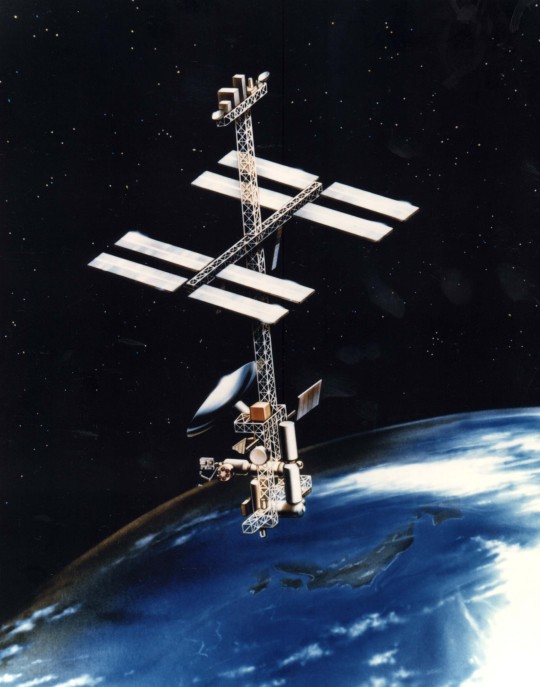
"This is an artist's conception of the proposed 'Power Tower' space station configuration, shown with the Japanese Experiment Module attached. This model and several others were examined before deciding on the Space Station Freedom structure that was later abandoned in favor of the International Space Station. Date: June 19, 1985."
There were nine articulated attachments for external payloads dedicated to Earth and space observation. The initial Station would have had a crew of six working on 12-hour shifts, and feature two US-developed laboratory modules plus two habitation modules.
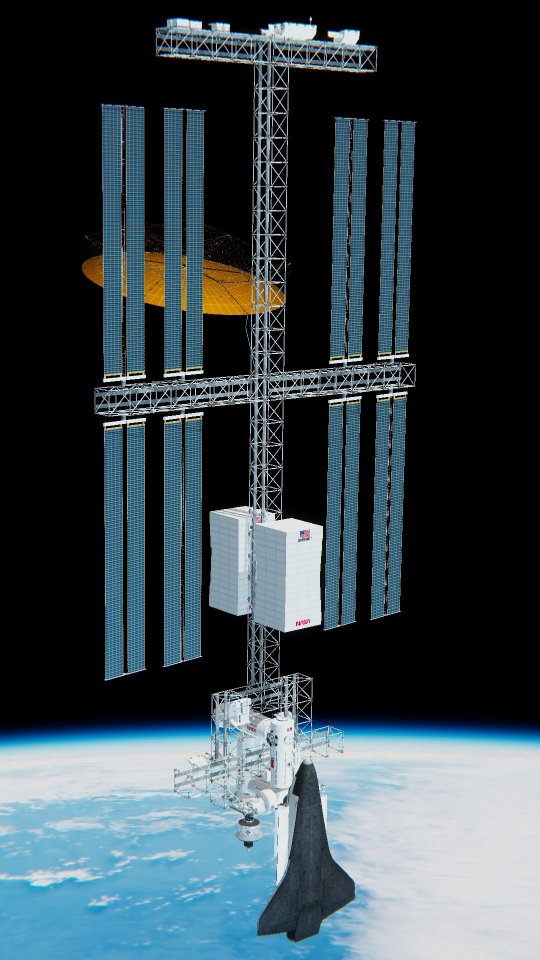
A maximum of 18 hours/week of EVA 'spacewalks' would be permitted per astronaut. International modules had not yet been incorporated in the design. The 'Power Tower' assembly schedule would have required 12 Shuttle flights over a three-year period, starting in April 1992. The Space Station would support research in a man-tended capability from April 1993 onwards. But the schedule was already starting to slip as the Office of Management and Budget reduced the Fiscal 1985 budget from $235 million to $150 million. The slight reduction increased the total cost to $8.1 billion at 1984 rates ($11.4 billion in current-year dollars).


Some observers were critical of the contractors' lack of independent involvement in the design process. They felt Station contractors did nothing but ape NASA's configurations in order to win the contract. In May 1987, former Space Station engineer Oliver Harwood testified in the Senate. 'Aerospace industry resources and capabilities were being squandered by 'rubber stamping' NASA designs instead of seeking independent and competitive solutions to system problems. Why were the artist's conceptions of eight major corporations so nearly identical? In a real competition seeking real answers there would be a different version for each of them.'
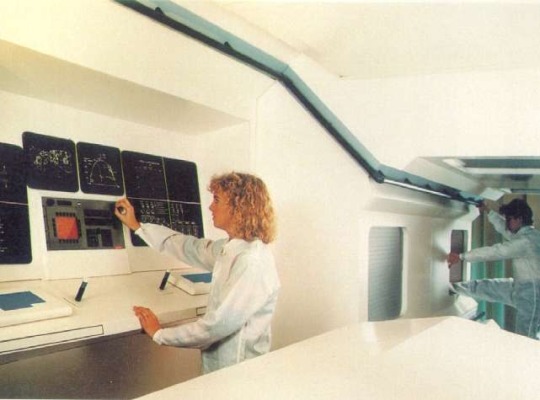
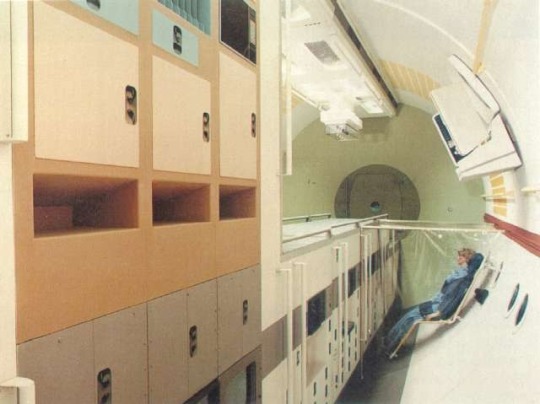
NASA allocated all Space Station definition work between four 'Work Packages' managed by its Johnson, Marshall, Goddard and Lewis Space Centers in July 1984. Work Package 4, led by the Lewis Research Center, would investigate Space Station power options. The two leading contenders were photovoltaic solar arrays and solar thermodynamic generators. Solar thermodynamic generators would use huge parabolic dishes to heat a fluid, which then powered electric generators. They were more efficient than traditional photovoltaic solar panels, had a longer lifetime and generated less atmospheric drag. But they also had to be pointed to within 1.5 degrees of the Sun to generate electricity, and the concept had never been tried before. NASA awarded contracts worth a combined $144 million to six contractor teams in April 1985, including $20 million to Work Package 4 contractors TRW and Lockheed. The agency still had not decided whether solar thermodynamic generators or photovoltaic arrays would be chosen. Another concept from the late 1980s would generate auxiliary power from the Earth's magnetic field by connecting a generator to a long electrically conducting tether. The other end was attached to the Space Station.


The McDonnell-Douglas 'Power Tower' Space Station crew modules were 10.7 meters long with docking ports at both ends. They would have been assembled end-to-end in a racetrack-like configuration. Some engineers felt this could have created dangerous dead-ends inside the Station if a module had to be depressurized. The contractors paid considerable attention to habitability issues since each crew would live and work on the Space Station for 90 days before returning to Earth. Rockwell's crew module proposal put all the equipment inside storage racks in the middle of the module rather than on the walls.
Article by Marcus Lindroos"
-Information from astronautix.com: link
NASA ID: 85-H-273
source, source, source
Mike Acs's Collection: link
NASA ID: C-1984-5784
SDASM Archives: 54059800
#Power Tower Space Station#Power Tower#Space Station Freedom#Space Station Concept#Space Station#Concept Art#NASA#Space#Earth
32 notes
·
View notes